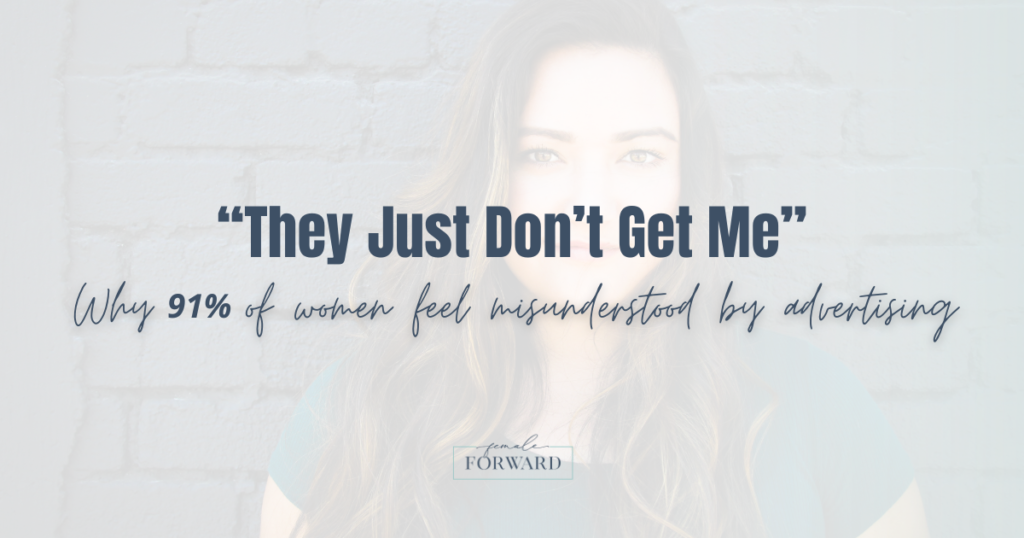
“They Just Don’t Get Me”
Why 91% of women feel misunderstood by advertising
Did you know that women are the most powerful consumers on the planet? They make 85% of all purchasing decisions and control 7 trillion dollars of buying power. But there’s a catch: most advertisers don’t know how to reach them effectively. In fact, 91% of women feel misunderstood by advertisers. This gap means that you have a huge opportunity to gain trust, customer satisfaction, and sales. Let’s talk about how to make women feel understood in advertising campaigns and how you can boost brand loyalty.
How to Connect with Women in Advertising Campaigns
The basic framework for connecting with women is not different than connecting with men. But each tactic needs to be tweaked to make it resonate with women in a way that is authentic and purposeful – and specific to your target audience.
Know Your Audience
Do your research and find out who your female customers are, what they want, what they need, what they value, and what they struggle with. Don’t rely on stereotypes or assumptions; use data, surveys, interviews, or focus groups to gain insights into their preferences and behaviors. Create specific segmentation maps for your customer set. Once you’ve identified the deep motivations for your ideal customer, you can create a message or persona that specifically resonates with them on a deeper level.
Use the research and segmentation you’ve done and layer in inclusivity and diversity. Celebrate it. Each segment is going to respond emotionally in different ways and to different tactics. But showing up for your target audience in the specifically diverse way that resonates with them, will make all the difference.
You know that Netflix uses segmentation in its advertising and streaming suggestions. But it also goes a step further. The ‘Strong Black Lead’ campaign highlighted specific diversity in movies and TV to promote the representation of Black women in its content, showing support and empowerment.
Speak Their Language
Use words, images, colors, and tones that match your audience’s personality and style (Hint: it’s not always pink!). Avoid jargon, clichés, or slang that might confuse or alienate your customer persona. Use humor, emotion, or storytelling to engage them and make them relate to your message.
Storytelling is a core asset when marketing to anyone, not just women. But women tend to resonate with stories on a more emotional and complex level than men. While men tend to take stories at face value and resonate with the facts of the story, women use a combination of the facts, what they have experienced or heard, and emotion to determine how they feel about the story. Using deeper methods of storytelling and connection will lead to improved brand loyalty and results with a female audience.
Show Them The Benefits
That’s not to say that women are all emotion and no facts. Not at all. Women tend to require that “the facts” go a step further. It’s not just about what the brand does; you need to show them how it can improve their lives. Focus on the outcomes and benefits, rather than just the features. Use testimonials, reviews, or case studies to demonstrate how your product or service has helped other women like them achieve their goals or solve their problems. Testimonials from fellow people that women trust (whether it’s a celebrity or a friend), pull a lot of weight in driving purchases. This is one of the primary reasons why influencer marketing can be so effective.
Check out this article on the Cult Phenomenon Stanley Tumbler, and how re-segmentation and testimonials from influencers turned around a failing brand.
Be Authentic
Don’t try to be something you’re not or pretend to care about something you don’t. Women have a heightened sense that tells them when an advertiser is being dishonest or manipulative. Be transparent, honest, and respectful in your communication. Show them that you understand their challenges and that you’re here to help them overcome them.
Transparency is core to authenticity. So if your brand can help women feel understood and visible, you’re well on your way to loyalty. Consider how your brand helps break down barriers for women. It may be as simple as talking about female issues that other brands skirt around (pun intended). If it makes sense for your brand and audience, talk about aging, or hormones, or mental health, or female stereotypes. Connect with women on a deeper level and gain their trust and loyalty.
Nike has run their ‘Dream Crazier’ campaign that is about breaking barriers, but also about breaking stereotypes. It speaks to empowering women, but not just in career and athletics, but also emotionally empowering them. It goes beyond the typical empowerment spot, to a deeper level of emotional connection that is specific to women.
Now that you know how to make women feel understood in your advertising campaigns, it’s time to put these tips into practice. Are you ready to make women feel understood and valued by your brand? If so, we have a challenge for you: create one ad that follows the tips we’ve given you here and test it with your female audience. Or if your brand could benefit from a workshop, let us know. We’re excited to see your business grow.
